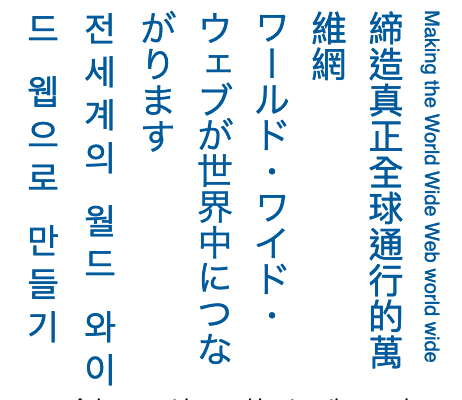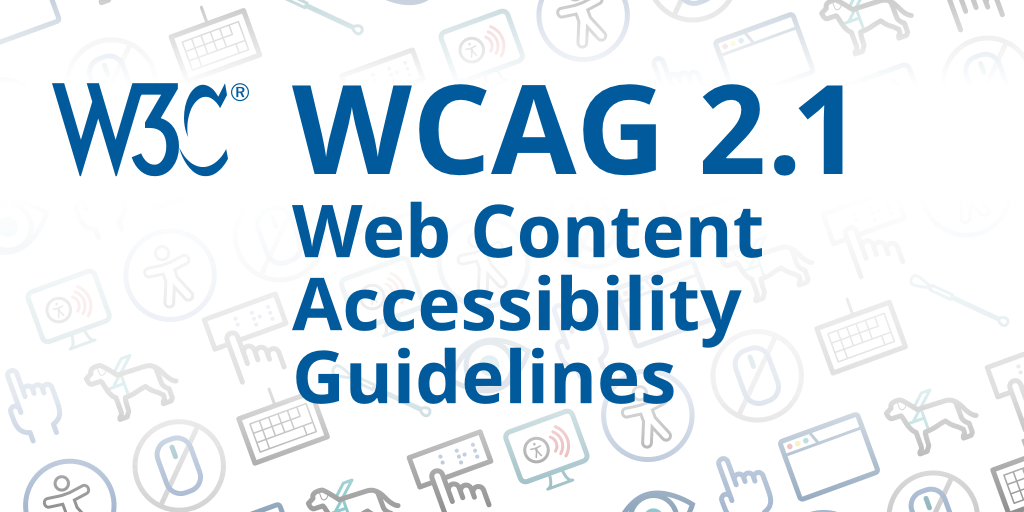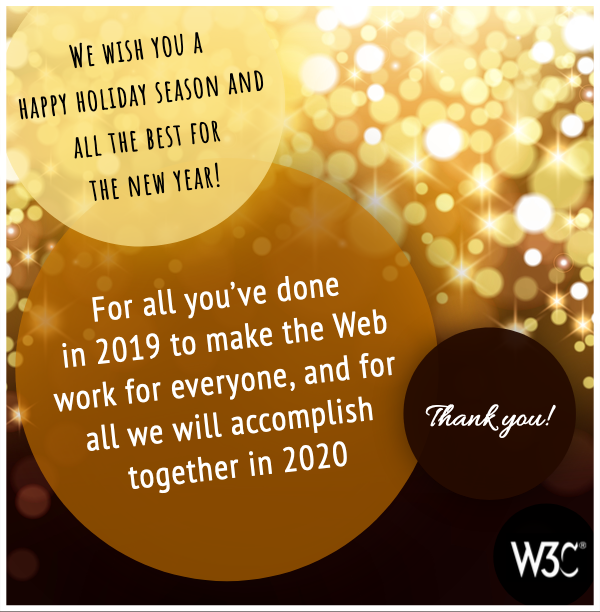News
Happy holidays from the World Wide Web Consortium!
13 December 2019 | Archive
W3C Recommends CSS Writing Modes to support International writing modes
10 December 2019 | Archive
 The CSS Working Group has published CSS Writing Modes Level 3 as a W3C Recommendation.
The CSS Working Group has published CSS Writing Modes Level 3 as a W3C Recommendation.
This CSS module defines CSS support for various international writing modes and their combinations, including left-to-right and right-to-left text ordering as well as horizontal and vertical orientations. These new CSS features allow a mixture of horizontal and vertical text regions on the same page. The specification also adds support for such things as isolation in bidirectional text, glyph orientation controls, and short, inline horizontal runs in lines of vertical text.
Please, read our press release for additional information and acknowledgements.
Updated Candidate Recommendation for the Web Real-Time Communication 1.0 API
13 December 2019 | Archive
The WebRTC Working Group invites implementation of its updated Candidate Recommendation of WebRTC 1.0: Real-time Communication Between Browsers specification.
The WebRTC API enables browsers to establish real-time audio, video and data transmission between browsers and other peers.
Since its previous publication as a Candidate Recommendation, the Working Group has resolved all its substantive issues, ensuring better alignment between the specification and its implementations, improving and clarifying support for “simulcast” transmission and built better support against possible race conditions when peers set up their connections.
Comments are welcome by January 12 2020.
W3C Invites Implementations of the Sensor APIs
12 December 2019 | Archive
 The Devices and Sensors Working Group invites implementations of four Candidate Recommendations:
The Devices and Sensors Working Group invites implementations of four Candidate Recommendations:
- Generic Sensor API defines a framework for exposing sensor data to the Open Web Platform in a consistent way. It does so by defining a blueprint for writing specifications of concrete sensors along with an abstract Sensor interface that can be extended to accommodate different sensor types.
-
Accelerometer defines
Accelerometer,LinearAccelerationSensorandGravitySensorinterfaces for obtaining information about acceleration applied to the X, Y and Z axis of a device that hosts the sensor. - Gyroscope defines a concrete sensor interface to monitor the rate of rotation around the device’s local three primary axes.
- Orientation Sensor defines a base orientation sensor interface and concrete sensor subclasses to monitor the device’s physical orientation in relation to a stationary three dimensional Cartesian coordinate system.
Comments are welcome by 8 January 2020.
W3C Invites Implementations of JSON-LD 1.1
12 December 2019 | Archive
The JSON-LD Working Group invites implementations of three Candidate Recommendations:
- JSON-LD 1.1 defines a JSON-based expression of Linked Data graphs. The syntax is designed to easily integrate into deployed systems that already use JSON, and provides a smooth upgrade path from JSON to JSON-LD. It enables the creation of more easily interoperable Web services, the ability to store Linked Data in JSON-based storage engines, and brings more meaningful data to Web services and APIs.
- JSON-LD 1.1 Processing Algorithms and API defines an Application Programming Interface (API) for developers implementing a set of algorithms for programmatic transformations of JSON-LD documents.
- JSON-LD 1.1 Framing allows developers to query a JSON-LD document’s contained graph, by example, and reshape output into a specific JSON tree layout.
Candidate Recommendation means that the Working Group considers the technical design to be complete and is seeking implementation feedback on the documents. The group is keen to get comments and implementation experiences on these specifications as issues raised in the documents’ respective GitHub repositories (see the document headers for the exact references).
The group expects to satisfy the implementation goals (i.e., at least two, independent implementations for each of the test cases) by 17 February 2020.
First Public Working Draft: Pointer Events Level 3
12 December 2019 | Archive
The Pointer Events Working Group has published a First Public Working Draft of Pointer Events Level 3. The features in this specification extend or modify those found in Pointer Events, a W3C Recommendation that describes events and related interfaces for handling hardware agnostic pointer input from devices including a mouse, pen, touchscreen, etc. For compatibility with existing mouse based content, this specification also describes a mapping to fire Mouse Events for other pointer device types.
Authorized Translation of WCAG 2.1 in Danish
12 December 2019 | Archive
 The World Wide Web Consortium published the Authorized Danish Translation of Web Content Accessibility Guidelines (WCAG) 2.1, Retningslinjer for Tilgængeligt Webindhold (WCAG) 2.1. The Lead Translation Organization for this Authorized Translation was the Digitaliseringsstyrelsen (Danish Agency for Digitization).
The World Wide Web Consortium published the Authorized Danish Translation of Web Content Accessibility Guidelines (WCAG) 2.1, Retningslinjer for Tilgængeligt Webindhold (WCAG) 2.1. The Lead Translation Organization for this Authorized Translation was the Digitaliseringsstyrelsen (Danish Agency for Digitization).
Translations in other languages are listed in WCAG 2 Translations. W3C Web Accessibility Initiative (WAI) particularly encourages the development of Authorized Translations of WCAG 2.1 and other technical specifications to facilitate their adoption and implementation internationally. Read about the Policy for W3C Authorized Translations.

